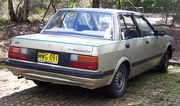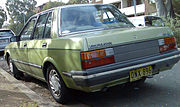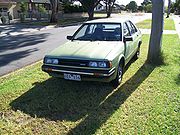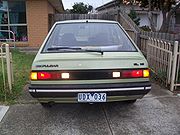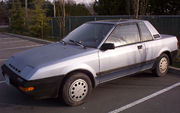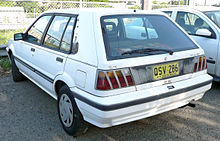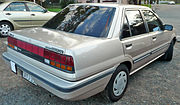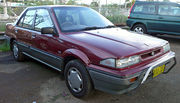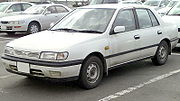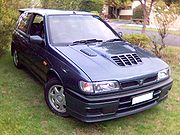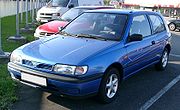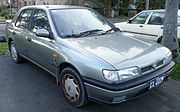- Nissan Pulsar
-
Nissan Pulsar Manufacturer Nissan Production 1978–2007 Assembly Clayton South, Victoria, Australia (until 1992) Predecessor Nissan Cherry Successor Nissan Tiida Class Subcompact (1978-1999)
Compact (2000-05)Body style 2-door coupé
3-door coupé
4-door sedan
5-door hatchbackThe Nissan Pulsar is an automobile that was produced by the Japanese automaker Nissan from 1978, when it debuted as a subcompact car, to 2007, when it was replaced in all markets by the Nissan Tiida. It was originally conceived as a replacement for Nissan's first front-wheel drive platform, the Nissan Cherry family (models E10 and F10). Although Pulsar models were mainly in front-wheel drive configuration, Nissan did offer four-wheel drive models during the 1980s to early-1990s, ultimately ending with the four-wheel drive turbocharged Nissan Pulsar GTI-R. Some models were sold as Nissan Sunny and Nissan Almera.
Contents
First generation (N10; 1978–1982)
N10 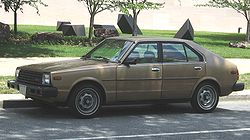
Also called Datsun 100A/120A/130A/140A/150A (Europe & Asia)
Datsun 310 (U.S.)
Datsun Cherry (Europe)
Datsun Pulsar (Malaysia)Production 1978–1982 Body style 2-door fastback
2-door van
3-door hatchback
4-door van
4-door sedan
4-door fastback
5-door hatchback
5-door station wagonLayout FF layout Engine 1.0L I4
1.2L I4
1.3L I4
1.4L I4
1.5L I4The Pulsar was first released in 1978 and was a subcompact car as was the Nissan Cherry it replaced. The N10 series Pulsar was exported to Australia and Malaysia with the Datsun Pulsar name. This model was known as the "Datsun Cherry" or "Datsun 100A/120A/130A/140A/150A" in Europe and Asia and the Datsun 310 in the U.S.. In Canada, the Datsun 310 was available with "Pulsar" striping on the rear quarters. The Nissan Langley, from 1980, was a more upmarket Pulsar.
The Pulsar was available as a three- or five-door hatchback, four-door sedan, a two or four-door van or station wagon, a two-door fastback with wraparound rear window, and a short-lived four-door fastback.
A mid-term facelift brought new E-series engines for 1981 and 1982. In Malaysia, Malay 1970's artist, Mazuin Hamzah was a ambassador of Datsun Pulsar E-Type 1300 N10 that marketed in Malaysia in the year of 1982.
The Nissan model N11 was not used on Nissan Pulsar N-range due to N11 was taken over by mini digger excavator since 1970's.
Second generation (N12; 1982–1986)
N12 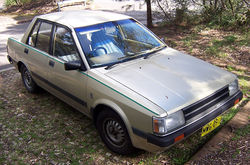
Also called Alfa Romeo Arna (Europe)
Holden Astra (Australia)
Nissan Cherry (Europe)Production 1982–1986
1982–1987 (Australia)Assembly Clayton South, Victoria, Australia Body style 2-door coupé
3-door hatchback
4-door sedan
5-door hatchbackLayout FF layout Engine 1.5L I4 A more angular version was announced in mid-1982. This model was also built in Italy by Alfa Romeo as the Arna (named after the joint venture which created it, Alfa Romeo Nissan Autoveicoli), using Alfa Romeo engines. Confusingly, the Italian models were also sold with Nissan badges, in Japan as the Nissan Pulsar Milano and in Europe as the Nissan Cherry Europe. At Alfa Romeo, the Arna was meant to replace lesser versions of the popular Alfasud, but never had the Italian car's appeal. The Cherry Europe also failed in its home market—lacking the build quality and reliability of its Japanese built twin car, yet at the same time managing to inherit the typical 1980s Alfa vulnerability to body corrosion.[citation needed]
By this time, Nissan had more or less standardized its naming policy worldwide, so as a Nissan it tended, with few exceptions, to be known as a Pulsar.
Those exceptions included related models in the Japanese home market. The Nissan Langley was a Pulsar with more powerful engines and four headlights. The Nissan Liberta Villa was a four-door version. The Nissan Pulsar EXA was a two-door coupé version with pop-up headlights. European markets continued with the Cherry name (as opposed to "Cherry Europe" for Alfa-built models).
The Pulsar EXA was known in North America as the Pulsar NX and shared many of its parts with the Nissan Sentra. This version of the Pulsar NX was available from 1983 to 1986 and came with either the fuel injected turbocharged E15ET engine or the carbureted naturally aspirated E16S engine. The Langley was built in Australia as the Nissan Pulsar, while the more standard Pulsar appeared there as the Holden Astra. The three-door and five-door hatchback versions of the Pulsar were also made available, replacing the old Datsun 310 hatchbacks, but they proved to be unpopular and they were withdrawn from Nissan's North American lineup after one year. The five-door hatchback remained in Australia until 1987, where it was known as the Pulsar ET Turbo and featured the E15ET engine.[citation needed]
Pulsar EXA Convertible — this limited edition model was designed to commemorate the 15th anniversary of Nissan Cherry dealerships. It was launched in May, 1985, and just 100 vehicles were made available for the whole of Japan. The vehicle sports numerous special accessories, including a soft top made from a special insulating material to keep out the rain and heat, and a rear window made from organic glass to ensure high visibility.
1982–1985 Nissan Pulsar (N12) GL sedan1985–1987 Nissan Pulsar (N12) GX sedan1986 Nissan Pulsar (N12) GL 5-door hatchback1986 Nissan Pulsar (N12) GL 5-door hatchback1986 Nissan Pulsar NX (U.S.)Third generation (N13; 1986–1990)
N13 
Also called Nissan Cherry
Nissan Sentra
Nissan Sunny (Europe)
Holden Astra (Australia)Production 1986–1990
1987–1991 (Australia)Assembly Clayton South, Victoria, Australia Successor Nissan NX (coupé) Body style 2-door coupé
3-door hatchback
4-door sedan
5-door hatchback
5-door station wagonLayout Front engine, front-wheel drive / four-wheel drive Engine 988 cc A10 I4[1]
1,270 cc E13 I4
1,392 cc GA14S/DS I4
1,487 cc E15 I4
1,497 cc GA15 I4
1,597 cc E16 I4
1,597 cc GA16 I4
1,598 cc 16LF (GM) I4
1,598 cc CA16DE DOHC I4
1,796 cc 18LE (GM) I4
1,809 cc CA18DE DOHC I4
1,680 cc CD17 diesel I4Transmission 5-speed manual
3-speed automaticWheelbase 95.7 in (2,431 mm) Length 166.5 in (4,229 mm) Width 66.1 in (1,679 mm) Height 51.0 in (1,295 mm) In 1986, Nissan's design chief refused to follow the smoother, aerodynamic look of other cars, and told his design team to come up with an affordable, subcompact car, which still has many advantages over a train, which many Nissan Pulsar drivers can also afford. A squarer Pulsar (N13 series) was released as a result; innovations included a four-wheel drive model. The Pulsar–Astra relationship continued in Australia, with the Langley sold as the Pulsar there and the four-door sedan version of the Nissan called the Pulsar Vector. The Langley also continued sales in Japan as a "Japanese-spec" Pulsar with a more powerful DOHC 1.8 L engine as opposed to its Holden sourced SOHC counterpart in Australia. The N13 Langley featured other options such as a limited-slip differential, luxurious interior and the much sought-after black headlights, center grille and round Skyline-style taillights. Driver side airbags were made a standard feature in the 1987 Nissan Pulsar NX, however passenger airbags were made an option in 1994. In countries such as New Zealand, the Sunny and Pulsar were combined into a single model, the Nissan Sentra — which differed (apart from the station wagon) from the models sold under the same name in the United States.
Versions in the United Kingdom were:
- 1.3 L/LS/GS (57 kW (76 hp) at 5,000 rpm)
- 1.3 LX (57 kW (76 hp) at 5,150 rpm)
- 1.4 LS/GS (64 kW (86 hp) at 5,000 rpm)
- 1.6 LX (69 kW (93 hp) at 4,800 rpm)
- 1.6 SLX (75 kW (101 hp) at 5,300 rpm)
- 1.6 GSX (85 kW (114 hp) at 5,800 rpm)
- 1.8 ZX (98 kW (131 hp) at 5,000 rpm)
four-cylinder engines offered in the Australian built version were:
- 1.6 L GM Family II 16LF, 1,598 cc, single point TBI, SOHC, 56 kW (75 hp) at 5,600 rpm, 125 N·m (92 lb·ft) at 3,600 rpm
- 1.8 L GM Family II 18LE, 1,796 cc, multi point EFI, SOHC, 79 kW (106 hp) at 5,600 rpm, 151 N·m (111 lb·ft) at 3,600 rpm
- 1.8 L GM Family II 18LE, 1,796 cc, multi point EFI, SOHC, 84 kW (113 hp) at 5,600 rpm, 162 N·m (119 lb·ft) at 3,600 rpm (SVD)
Saloon models were badged as Pulsar; this was the basis for the badge-engineered Holden Astra. After Holden ended their cooperation with Nissan in 1989 (and took up with Toyota instead), sales of the Holden Astra came to an end. Nissan Australia, however, kept using the GM engines until the succeeding N14 version was introduced.
In Europe, the N13 Pulsar was usually sold as the Nissan Sunny, unrelated, however, to the Sunny sold in Asia. In some markets (such as Greece), the N13 Pulsar retained the Cherry nameplate.[1] In Malaysia, it was sold as the Nissan Sentra, different from the Nissan Sentra sold in the America and visually similar to the European Nissan Sunny. In South Africa it was sold as the Nissan Sabre. There were three and five-door hatchbacks and a four-door sedan.
The (Japanese: Nissan EXA) was spun off as its own model, with an innovative modular rear end: customers could opt for a coupé, hatchback or an open-top car. In Japan and the US, the EXA also had the Sportbak wagon option. This version was actually based on the North American B12 "Sentra" chassis, and was equipped with the CA16DE engine. This version of the EXA was available in North America under the name Pulsar NX.
The North American Pulsar NX was offered in two distinct trim levels: the economical XE (1.6 litre E16i in 1987–1988 and 1.6 litre GA16i in 1989–1990) and the twin-cam, performance-oriented SE (1.6 litre CA16DE in 1987 and 1.8 litre CA18DE in 1988–1989).
In Australia, the Series 1 EXA (1987) came with the CA16DE, vinyl rear seats, front vented disk with rear drum brakes, and power steering. The Series 2 EXA (1988–1989) featured the CA18DE and cloth rear seats. There were also two GP versions of the S2 EXA made. 45 white GP edition vehicles were specially made for the celebrity race at the Adelade Grand Prix in 1988. They had all the features of the Series 2, but also had SSS pulsar wheels, build numbers on a badge in the dash and a factory roll cage which was removed after the race. The 1989 GP featured all the same features of the Series 2 EXA. They also had the Pulsar SSS wheels, a more aggressive front bumper, and build numbers on a badge in the dash. All 200 89 GPs made were red. The Series 3 (1990–91) EXA added rear disc brakes, improved seats and optional power windows. The Nissan EXA Solair was a luxury version of the base model that featured power windows, 5 spoke alloy wheels, and a different front bumper. In 1991, Kodak had a competition for five fully optioned Series 3 Nissan EXAs. The Kodak EXAs featured an exclusive pearlescent yellow paint scheme.
Engines offered in the North American Pulsar NX:
1987
1988
1989
1990
- 1.6 L GA16i, 1597 cc, single point TBI, SOHC
The EXA/Pulsar NX was replaced in 1991 with the Nissan NX coupe.
1987–1989 Nissan Pulsar (N13) GL 5-door hatchback (Australia)1987–1999 Nissan Pulsar (N13) Vector GXE sedan (Australia)1989–1991 Nissan Pulsar (N13 S2) Ti GL sedan (Australia)19891991 Nissan Pulsar (N13 S2) Q 5-door hatchback (Australia)1989–1991 Nissan Pulsar (N13 S2) Vector GL sedan (Australia)Nissan EXA (N13)Fourth generation (N14; 1990–1995)
N14 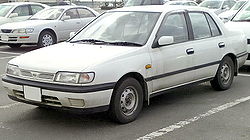
Also called Nissan Sentra
Nissan Sunny (Europe)
Arex PulsarProduction 1990–1995 Assembly Miáolì Xiàn, Miaoli, Taiwan
Clayton South, Victoria, Australia (1991–1992)
Yajima, JapanBody style 3-door hatchback
4-door sedan
5-door hatchback
5-door station wagonLayout FF layout Engine 1.6L I4
2.0L I4Related Nissan Wingroad
Nissan AdvanIn 1990, the N14 model saw Nissan turn to a more rounded design. The Langley and Liberta Villa model names were discontinued.
This version continued to be offered in New Zealand as the Sentra (unrelated to the version sold in North America. In Europe, the Sunny name continued, applied to three-door hatchback, five-door hatchback and four-door sedan models, alongside the Sunny California station wagon from Japan (called either the Sunny Estate or Sunny Traveller).
There was no N14 Pulsar offered in the United States or Canada either; instead, the North American Pulsar for those markets evolved into what was known as the NX1600 with the GA16DE engine, the SR18DE or the NX2000 with the SR20DE engine and rear disc brakes. The NX cars are sport coupe shape of the same chassis, engines, body electronics and even dashboard as Pulsar and Sunny. 1994 was the last year for the N chassis in the US.
The Taiwanese Pulsar, was manufactured by Yulon under its AREX brand - where it got the same engine from the Japanese Version.
Japan
In Japan, the N14 range was large, comprising 8 different models with a total of 18 available variations, including 6 different engines, 3 body shapes and 2 drivetrains.
The N14 series also saw the introduction of the Nissan Pulsar GTI-R (chassis code E-RNN14 in Japan, and badged as Sunny GTI-R in Europe with chassis code EGNN14). This was a homologation variant produced to satisfy the necessary WRC rules at that time. It featured a turbocharged SR20DET engine producing 169 kW (230 bhp JIS) and the ATTESA all-wheel drive system.
- Engines
- CD17 1,680 cc (1.68 L; 103 cu in), 55 PS (40 kW; 54 hp)@4800, 10.6 kg·m (104 N·m; 77 lb·ft)@2800
- GA13DS 1,295 cc (1.295 L; 79.0 cu in), 79 PS (58 kW; 78 hp)@6000, 10.6 kg·m (104 N·m; 77 lb·ft)@3600
- GA15DS 1,497 cc (1.497 L; 91.4 cu in), 94 PS (69 kW; 93 hp)@6000, 12.8 kg·m (126 N·m; 93 lb·ft)@3600
- GA16DE 1,596 cc (1.596 L; 97.4 cu in), 110 PS (81 kW; 108 hp)@6000, 15 kg·m (150 N·m; 110 lb·ft)@4000
- SR18DE 1,838 cc (1.838 L; 112.2 cu in), 140 PS (103 kW; 138 hp)@6400, 17 kg·m (170 N·m; 120 lb·ft)@4800
- SR20DET 1,998 cc (1.998 L; 121.9 cu in), 230 PS (169 kW; 227 hp)@6400, 29 kg·m (280 N·m; 210 lb·ft)@4800
- Models
Model Engine Drivetrains Bodies V1 GA13DS FWD 3 or 4 door M1 GA15DS or CD17 FWD or 4WD 4 door K1 GA15DS or CD17 FWD or 4WD 4 or 5 door J1J GA15DS FWD 4 door X1 GA15DS FWD or 4WD 3 door X1R GA16DE FWD 3, 4 or 5 door GTI SR18DE FWD 3, 4 or 5 door GTI-R SR20DET 4WD 3 door Australia
In Australia, the N14 (aka ES) was available in 4 models, all FWD only, in 4-door sedan or 5-door hatch variations. Nissan Australia assembled the range that sold from October 1991 through to February 1993 at their factory in Clayton South, Victoria. After Nissan closed the plant in October 1992 for financial reasons, the models (known as the "Series 2") were imported from Japan and sold until September 1995. unlike the N13, Holden in Australia did not use a variant of this Pulsar, instead choosing to use a rebadged variant of the rival Toyota Corolla, which they sold as the Holden Nova until the late 1990s when they reintroduced the Astra name for their variant of the Opel Astra. The Pulsar N14 was awarded Australian Wheels magazine's Car of the Year in 1991, which it shared with the Honda NSX.
- Engines
- GA16DE 1,596 cc (1.596 L; 97.4 cu in), 110 PS (81 kW; 108 hp)@6000, 15 kg·m (150 N·m; 110 lb·ft)@4000
- SR20DE 1,998 cc (1.998 L; 121.9 cu in), 143 PS (105 kW; 141 hp)@6400, 18 kg·m (180 N·m; 130 lb·ft)@4800
- Models
Model Bodies Engine GLi 4 or 5 door GA16DE Q 5 door GA16DE or SR20DE (option) TI 4 or 5 door SR20DE SSS 5 door SR20DE South Africa
In South Africa the N14 (aka ES) was built locally by Nissan South Africa and badged as the Sabre. It was only available in a five-door hatch and FWD. Originally released in 1994, and given a cosmetic "facelift" in 1997 rather than being replaced with the N15, it was produced until 2000 and also exported to Namibia.
- Engines
- GA16DS 1,596 cc (1.596 L; 97.4 cu in), 99 PS (73 kW; 98 hp)@6000, 15 kg·m (150 N·m; 110 lb·ft)@4000
- GA16DNE 1,596 cc (1.596 L; 97.4 cu in), 110 PS (81 kW; 108 hp)@6000, 15 kg·m (150 N·m; 110 lb·ft)@4000
- SR20DE 1,998 cc (1.998 L; 121.9 cu in), 143 PS (105 kW; 141 hp)@6400, 18 kg·m (180 N·m; 130 lb·ft)@4800
- Models
Model Engine 160 GX GA16DS 160 GXi GA16DNE 200 GXi SR20DE Pulsar 4-door sedan (Japan)Pulsar GTI-R (Japan)Sabre 200 GXI (facelift) (South Africa)Sunny 3-door Hatch (Europe)Pulsar 5-door hatch (Australia)Fifth generation (N15; 1995–2000)
N15 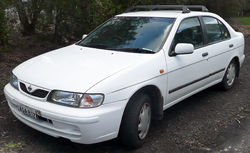
Also called Nissan Sentra
Nissan Almera (Europe)
Arex PulsarProduction 1995–2000 Assembly Miáolì Xiàn, Miaoli, Taiwan
Clayton South, Victoria, AustraliaBody style 3-door hatchback
4-door sedan
5-door hatchbackLayout Front engine, front-wheel drive / four-wheel drive Engine 1,500 cc (1.5 L) I4
1,600 cc (1.6 L) I4
1,800 cc (1.8 L) I4
2,000 cc (2.0 L) I4Related Nissan Primera
Nissan Sunny
In 1995, the N15 Pulsar was launched and sold in Europe as the Nissan Almera. The New Zealand Nissan Sentra changed name to Pulsar after the Nissan assembly plant in Wiri, Auckland closed down in 1998, in favour of imports from Japan. Again, four and five-door models were offered, with three door models being available in Europe only, and not Australia and New Zealand.The Australasian versions included the LX, SLX, Q and SSS variants. New Zealand specific versions included the S and SE variant. The SSS model (5-door hatch only) featured the SR20DE engine featuring 105 kW (141 hp)/179 Nm. The station wagon continued to be from the Sunny, later spun off in Japan into the Nissan Wingroad.
Japan
In Japan, the N15 was available under numerous nameplates. These included:
Pulsar Serie Rezzo 3-door hatch (GA15DE engine, base JDM Pulsar, indicative features include absent rear high stop lamp and front fascia black slatted spotlight covers until 1998 facelift).
Lucino BB 3-door hatch (GA15DE engine, exactly same as Pulsar Rezzo, except for rear indicator lens covers being clear coloured).
Pulsar Serie X1 3-door hatch and 4-door sedan (GA15DE engine, indicative features included high stop lamp incorporated into rear spoiler (hatch and sedan) or bootlid (sedan only) and option of driving lights. Front fascia differs to that of Pulsar Serie Rezzo).
Lucino JJ 3-door hatch(GA15DE engine, exactly same as Pulsar Serie X1, except for rear indicator lens covers being clear coloured).
Pulsar Serie X1R 3-door hatch and 4-door sedan (exactly same as Pulsar Serie X1 and Lucino JJ, except GA16DE engine featured instead of GA15DE).
Pulsar CJ-I and Pulsar CJ-II 4-door sedan (GA15DE engine, exactly same as Pulsar Serie Rezzo).
Pulsar SR-V 5-door hatch (GA15DE or SR18DE engine, indicative features include rear number plate surround fascia, front nudge bar and two-toned paint scheme).
Lucino SR-V 5-door hatch (exactly same as Pulsar SR-V, except rear indicator lens covers being clear coloured).
Pulsar GTI 3-door hatch and 4-door sedan (SR18DE engine, indicative features include 15" alloy wheels).
Pulsar 5-door hatch (GA15DE engine, exactly same as Pulsar and Lucino SR-V but without two-tone paint, nudge bar and rear number plate surround fascia).
Pulsar VZR 3-door hatch (SR16VE engine, available from 1998 onwards only, featured Nissan's NEO VVL technology and 15" alloys from Pulsar GTI, 175bhp).
Pulsar SR-V VZR 5-door hatch (SR16VE engine, exactly same as Pulsar VZR 3-door hatch).
Lucino SR-V VZR 5-door hatch (SR16VE engine)
A 4-wheel drive option was available in Pulsar SR-V, Lucino SR-V and Pulsar CJ-I, CJ-II and X1 (sedan only) models.
JDM N15 Pulsar and Lucino models had drivers airbag as standard. Passenger airbag was an option in 1995 and standard from 1996 onwards. Speedometer became digital from 1998. Tachometer was not present on Pulsar Serie Rezzo, Pulsar CJ-I, CJ-II and Lucino BB models. Air conditioning was standard on almost all models, but could be requested without. Manual adjusting windows were available on Pulsar Serie Rezzo, Pulsar CJ-I, CJ-II and Lucino BB models, otherwise electric windows were standard. Sunroof was available option on Pulsar Serie X1, Pulsar Serie X1R, Pulsar GTI, Pulsar VZR and Pulsar / Lucino SR-V models (hatch only). Manual controlled air conditioning controls were standard, climate control was available as option and standard on Pulsar Serie X1R, Pulsar GTI and Pulsar VZR.
An Autech tuned version of the Pulsar SRV and Lucino SRV was also available featuring the SR18DE block, but was actually a 2.0L (1998cc) engine. Indicative features included the placement of the spare-wheel on the rear boot lid and inclusion of plastic side mouldings over the wheel arches and large rear spoiler. As a result of shifting the spare-wheel to the boot lid, the number plate had to be relocated in the rear bumper, meaning a bumper was produced specific for this model.
Configurations:
The N15 Nissan Pulsar came with the following engine options:
GA15DE — 1500 cc DOHC MPFI. Featured in the New Zealand Sentra S, JDM Pulsar Serie Rezzo, JDM Pulsar Serie X1, JDM Pulsar CJ-I, JDM Pulsar CJ-II, JDM Pulsar SR-V, JDM Lucino BB, JDM Lucino JJ and JDM Lucino SR-V. There was a 4-wheel drive variant of the GA engine series available in the JDM Pulsar SR-V and JDM Lucino SR-V 5-door hatch and some JDM Pulsar CJ-I, Pulsar CJ-II and JDM Pulsar X1 4-door sedans.
GA16DE — 1600 cc DOHC multi-point EFI (sometimes ECCS featured). Featured in the Australian and New Zealand new models Sentra SE, Sentra SLX Sentra Q and JDM Pulsar X1R hatch and sedan variants.
SR18DE — 1800 cc DOHC multi-point EFI. Featured in the JDM Pulsar GTI 3-door hatch and 4-door sedan, JDM Pulsar SR-V 5-door hatch models. 4-wheel drive variant of SR engine series available in JDM Pulsar SR-V model.
SR20DE - 2000 cc DOHC multi-point EFI. Featured in Australian and New Zealand (Australian assembled) Sentra and Pulsar SSS variant delivered with silver/red rocker cover, also called "Red Top" 105 kW @ 6400rpm / 179Nm @ 4800rpm-4800rpm / 0-100 km/h 8.8 secs / Kerb weight 1142 kg.
Autech Version SR20DE — 1998 cc DOHC multi-point EFI. Only Sold locally in Japan. Was used in Serie and Lucino Japanese Variants (576 produced total). Featured compression ratio of 11.5:1, 264 duration @ 11.4 mm lift camshafts, unique valve springs, DET vales, portwork, piston oil squirters and unique pistons to achieve high compression. Power is stated at 180 bhp/130 kW @ flywheel. 191 nm@4800rpm.
SR16VE — NEO VVL (Nissan Ecologically Orientated Variable Valve Timing and Lift). Featured in JDM Pulsar Serie VZ-R.
SR16VE N1 — Featured in the JDM Pulsar VZ-R N1, which was a racing homologation version intended to compete with the Honda Civic Type-R. Producing 200 PS (147 kW; 197 hp) from its 1.6 L SR16VE engine, it held the highest specific output ever for a naturally aspirated production car, at 123.125 hp/litre until the Honda F20C engine was released in the Honda S2000. The "Version2" (VerII) was introduced offering a few chassis and mechanical tweaks as well as an option orange trimmed interior with GTR Skyline front seats. N1's available in Black and White only.
The N15 was the last Pulsar generation manufactured under the Taiwanese AREX brand. The AREX Pulsar 150 was only available as an sedan. It was very similar to the Japanese version.
1997 Nissan PulsarSixth generation (N16; 2000–2005)
N16 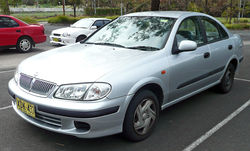
Also called Nissan Sentra
Nissan Sunny
Nissan Bluebird Sylphy
Nissan AlmeraProduction 2000–2005 Assembly Kuala Lumpur, Malaysia
Washington, Tyne and Wear, EnglandBody style 4-door sedan Layout FF layout Engine 1.3L I4
1.8L I4
1.5L I4
1.6L I4
2.0L I4
2.2L I4In 2000, Nissan launched the N16 Pulsar, which included a compact MPV version (the Nissan Almera Tino or Nissan Tino) for the first time. The Wingroad continues to be sold as the Pulsar Wagon or Almera Traveller in many countries. To keep the Bluebird nameplate alive, Nissan shifted it to the four-door version of the Pulsar, and named it the Nissan Bluebird Sylphy for the Japanese Domestic Market (JDM).
In the Philippines, Taiwan, Malaysia, and Indonesia, the Bluebird Sylphy is sold as the Nissan Sentra. In New Zealand and Thailand, the five-door Pulsar is imported from the UK, while the four-door model is essentially a rebadged Bluebird Sylphy. Consequently, each body style has a different front end. In Thailand, Singapore, and China, the N16 Bluebird Sylphy is sold as the Nissan Sunny.
In Indonesia, the Bluebird Sylphy or Pulsar is known as Sentra 1.8 Super Saloon. This model is for private use and sold between 2002 and 2004. It has standard ABS, dual SRS airbag, leather interior, and CD player with MP3. The facelifted model N16 is Sunny Neo 1.6, and intended for taxi use only.
For 2004, the N16 Bluebird Sylphy and Pulsar got facelift with revised grille, and a whole new rear end with "Teana-like" taillights. The N16 Sunny and Sentra were also received totally new front end.
After the Japanese production of Bluebird Sylphy G10 and Pulsar N16 were discontinued, the Sentra N16 is still manufactured and sold in the Philippines and Malaysia. The models for Malaysia are SG and SG-L, with the choice of Comfort or Luxury Package. The Sunny is continued to be offered in Singapore. Trim levels are EX Saloon, Super Saloon, and Luxury Edition.
N16 Model Engines:
- 1.5L LX Pulsar (Hatch), Almera, Sunny NEO, Bluebird Sylphy - DOHC 16 valve QG15DE 81 kW (109 hp)@4000 rpm, 143 N·m (105 lb·ft)@4400 rpm
- 1.6L Sunny NEO, Sentra, LX Pulsar, Bluebird Sylphy - DOHC 16 valve N-VCT QG16DE 88 kW (118 hp)@6000 rpm, 165 N·m (122 lb·ft)@4000 rpm
- 1.8L Sentra, LX Pulsar, Almera, Bluebird Sylphy - DOHC 16 valve N-VCT QG18DE 94 kW (126 hp)@6000 rpm, 175 N·m (129 lb·ft)@2400 rpm
- 2.0L Bluebird Sylphy - DOHC 16 valve QR20DE 110 kW (148 hp)@6000 rpm, 200 N·m (148 lb·ft)@4400 rpm
- 2.2L Almera - Diesel Common Rail Direct Injection YD22DDTi (2003-2005) 82 kW (110 hp)@4000 rpm, 247 N·m (182 lb·ft)@2000 rpm
In October 2005, a new Nissan Bluebird Sylphy (G11 series) was previewed and appeared at the Tokyo Motor Show. In Japan, the Nissan Tiida hatchback and Tiida Latio sedan replaced the Pulsar in 2004. The Tiida range was introduced in Australia and New Zealand in early 2006, certain European markets in 2007, and also the United States, as the Versa. In 2005 a concept car called the Nissan AZEAL debuted at the Detroit Auto Show. The Azeal, a front wheel drive sport coupe aimed at the youth market, is described as a successor to the Pulsar NX.
Australia
In Australia and New Zealand, Nissan continued to use the "Pulsar" name for the N16. Four-door sedan and five-door hatchback versions were offered.
Trim levels were LX, ST, Q and Ti. Engine choices consisted of a 1.6-litre (QG16DE) or a 1.8-litre (QG18DE) four-cylinder with 16 valves. Power output was 88 kW (118 hp) and 94 kW (126 hp). The four-door was available in four trim levels - an LX with the 1.6, the ST and Ti with the 1.8-litre engine as standard, and a Q version with the 1.8 motor and a sportier level of trim, including a rear spoiler and alloy wheels.
In the five-door range there was no LX version, this being four-door only. Nissan launched the hatchback model with the ST trim level and a sporty Q version. As such, all hatches were 1.8-litre powered. The base-model LX sedan came with a driver's airbag, air-conditioning, remote locking and power mirrors, although no anti-lock brakes (ABS) or power windows were offered. The ST five-door gained an extra front airbag, whereas the four-door model did not have one as standard.
In Ti form, the four-door gained both front airbags, ABS, climate-control air-conditioning, alloy wheels and power windows. The Q model was similar to the Ti four-door, although there were slight discrepancies between the sedan and hatch, with the latter version gaining an extra air-bag and 15-inch alloy wheels versus the 14-inch alloys on the sedan.
References
- N14 Pulsar - Japanese Brochure Specs
- N14 Pulsar - Australian Brochure
- N14 Pulsar - Australian Buyers Guide
- N14 Pulsar - Australian History Article
- N14 Sabre - South African Brochure
- N14 Sabre - South African Article
- N14 Sabre - South African Test
- N15 Pulsar - Nissan Japan Historical Site
- N15 Lucino - Nissan Japan Historical Site
External links
 Media related to Nissan Pulsar at Wikimedia Commons
Media related to Nissan Pulsar at Wikimedia CommonsNissan Motor Company Vehicles Current370Z • Advan • Altima • Aprio • Armada • Atlas • Bluebird • Bluebird Sylphy • Cabstar • Caravan • Civilian • Clipper • Cube • Dualis • Elgrand • Frontier • Freeson • Fuga • GT-R • Juke • Lafesta • Leaf • Livina Geniss • Maxima • March • Murano • Moco • Navara • Note • NV200 • NV400 • Otti • Paladin • Pathfinder • Patrol • Qashqai • Quest • Rogue • Safari • Sentra • Serena • Skyline • Teana • Tiida • Titan • Urvan • Versa • Wingroad • X-Trail • XterraPastDC-3 • 100NX • 1200 • 310 • 180SX • 200SX • B-210 • 240SX • 240Z • 280ZX • 300C • 300ZX • 350Z • 510 • 810 • Almera • Almera Tino • Altra (EV) • Avenir • Auster • Bassara • Be-1 • Caball • Cablight • Cedric • Cefiro • Cherry • Cima • Crew • Datsun Truck • Echo • Expert • Fairlady • Figaro • Gazelle • Gloria • Hardbody Truck • Hypermini • Homy • Interstar • Junior • Largo • Laurel • Leopard • Liberty • Mistral • Multi • NX • Pao • Pintara • Pino • Platina • Prairie • Presage • Presea • Primera • President • Pulsar • Pulsar GTI-R • R390 GT1 • R'nessa • Rasheen • Roadster-Road Star • S-Cargo • Saurus • Saurus Jr • Silvia • Sileighty • Skyline GT-R • Stanza • Stagea • Sunny • Terrano • Terrano II • Vanette • VioletConcept126X • 216X • 270X • 300 Bambu • 315-a • AA-X • Actic • AD-1 • AD-2 • AL-X • Alpha T • Amenio • AQ-X • AP-X • ARC-X • AXY • AZEAL • Bevel • Boga • C-Note • Chapeau • Chappo • Cocoon • CQ-X • Crossbow • CUE-X • Cypact • Duad • Dunehawk • Effis • ESV • Evalia • EV Guide II • EV Truck • FEV • FEV-II • Foria • Forum • Fusion • Gobi • GR-1 • GR-2 • GT-R • ideo • Intima • Jikoo • Judo • Jura • Kino • KYXX • Land Glider • LEAF • LUC-2 • MID4 • Mixim • mm.e • Moco • Nails • NCS • NEO-X • NRV-II • NX-21 • NV2500 • Pivo • Pivo 2 • Qazana • Redigo • Round Box • Serenity • Sport Concept • Stylish VI • Terranaut • Tone • Townpod • Trailrunner • TRI-X • URGE • UV-X • XIX • XVL • Yanya • ZarootEngines GRX-3 • UD12 • VRT35Marques Nissan • InfinitiSubsidiaries
and divisionsSee also ATTESA • Datsun • HICAS • Prince • Renault-Nissan Alliance • Nissan Shatai • UD Nissan Diesel • VVL • VVEL • dCi
 Category ·
Category ·  Commons
CommonsNissan car timeline, European market, 1980s–present Type 1980s 1990s 2000s 2010s 0 1 2 3 4 5 6 7 8 9 0 1 2 3 4 5 6 7 8 9 0 1 2 3 4 5 6 7 8 9 0 1 Supermini Micra K10 Micra K11 Micra K12 Micra K13 Small family car Cherry N10 Cherry N12 Sunny B310 Sunny B11 Sunny N13 Sunny N14 Almera N15 Almera N16 Tiida C11 Large family car Stanza T11 Bluebird 910 Bluebird U11 Bluebird T12/T72 Primera P10 Primera P11 Primera P12 Executive car Laurel C31 Laurel C32 Maxima J30 Maxima QX A32 Maxima QX A33 Teana J31 Teana J32 Coupé Silvia S110 Silvia S12 200SX S13 200SX S14 Sports car 280ZX 300ZX Z31 300ZX Z32 350Z Z33 Mini MPV Note Compact MPV Prairie M10 Prairie M11 Almera Tino Large MPV Serena C23 Serena C24 Serena C25 Mini SUV Juke Crossover SUV Qashqai Qashqai+2 X-Trail T30 X-Trail T31 Murano Z50 Murano Z51 Terrano WD21 Pathfinder R50 Pathfinder R51 Off-roader Terrano II Patrol 160 Patrol Y60 Patrol Y61 Patrol Y62 Categories:- Cars of Australia
- Nissan vehicles
- Compact cars
- Subcompact cars
- Front wheel drive vehicles
- All wheel drive vehicles
- Coupes
- Hatchbacks
- Sedans
- Station wagons
- Vans
- Vehicles introduced in 1978
Wikimedia Foundation. 2010.

